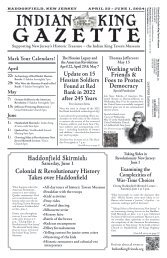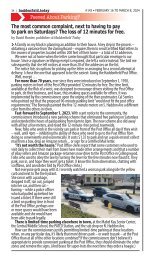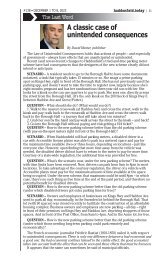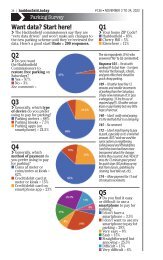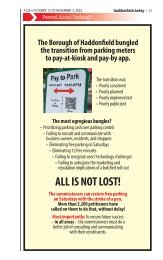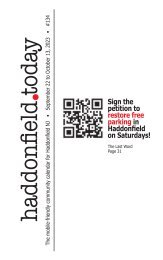You also want an ePaper? Increase the reach of your titles
YUMPU automatically turns print PDFs into web optimized ePapers that Google loves.
#<strong>149</strong> • JUNE 21 TO JULY 12, 2024<br />
Bancroft: Woodmont Q&A<br />
haddonfield.today | 43<br />
Q11. Architectural Style<br />
› In what ways will you customize the “Woodmont style” (i.e. the typical external<br />
appearance of your developments) to suit <strong>Haddonfield</strong>’s historic and architectural<br />
environment and the community’s sensibilities?<br />
ANSWER: Every town and every project is different. Communities we have constructed<br />
in other towns have been designed to respond to their specific contexts. As just a few<br />
examples, our red-brick buildings in historic Morristown differ from our modern loft building<br />
in Red Bank that differ from our garden-style buildings in more suburban locations.<br />
This community will be designed to harmonize with <strong>Haddonfield</strong>’s historic architecture.<br />
We will continue to study the heritage of <strong>Haddonfield</strong> and bring forth designs that capture<br />
both the specific community heritage of <strong>Haddonfield</strong>, and foster aspirations for its future.<br />
Throughout the design process, we would seek to incorporate community viewpoints and<br />
perspectives through collaboration with the Borough, its residents, and other stakeholders.<br />
We don’t have a rendering to share of these buildings not only because their overall form<br />
is still to be determined but their architecture as well. This will be a clean-sheet design that<br />
will be created and refined through the above process.<br />
Q12. Environmental Factors<br />
› What effects, if any, will your project have on the 300-foot riparian zone along the Cooper<br />
River? Conversely, what effects, if any, will the 300-foot riparian zone have on your project?<br />
ANSWER: This project will adhere to the NJDEP regulations governing the 300-foot riparian<br />
zone along the Cooper River. We will be removing most existing paved areas in this buffer,<br />
which will result in a substantial net reduction in impervious and an increase in vegetated<br />
area. As we return this area to nature, we are proposing a mulch walking path open to the<br />
public that will meander through this bucolic viewshed.<br />
In addition, the extensive stormwater management measures that we will institute will<br />
enhance the quality and reduce the overall flow of water from the property to the Cooper<br />
River.<br />
Q13. Property Taxes<br />
› Woodmont has proposed to make periodic payments to the municipality in lieu of<br />
property taxes. What is a PILOT (Payment In Lieu of Taxes), and why is it an appropriate<br />
mechanism for the Bancroft redevelopment project?<br />
ANSWER: Under New Jersey law PILOTs come in different forms, but the PILOT being<br />
considered at Bancroft is what is known as a long-term tax abatement. Under the existing<br />
ad valorem tax methodology, taxpayers pay real estate taxes based upon a percentage of the<br />
assessed value.<br />
Under the State statutory PILOT rules set forth in NJSA 40A:20-1 et seq., the property<br />
owner pays a percentage of gross income to the town so that the town directly shares in<br />
the success of the project as rents increase over time. The percentage typically varies from<br />
10% to 15%, so every time the landowner receives $1, ten to fifteen cents goes to the town.<br />
The term of the PILOT is typically 25 to 30 years, with the project converting to ad valorem<br />
taxation upon expiration of the PILOT term.<br />
Many municipalities around the State are employing PILOTs to assist them in meeting<br />
their affordable housing requirements and in encouraging redevelopment of under-utilized<br />
properties to increase their tax base. Importantly, municipalities cannot simply issue a<br />
PILOT – pursuant to State law, a town must first conclude that the site is an “area in need<br />
of redevelopment” and the redeveloper must then demonstrate a need for the program<br />
through a financial showing.<br />
At Bancroft, development of the affordable homes, the requirement to refurbish<br />
dilapidated historic buildings, and the possible need for off-site improvements on top of the<br />
already high construction and financing costs of the project will drive a showing of need.<br />
These answers were provided by Woodmont Properties in response to questions asked by <strong>Haddonfield</strong> <strong>Today</strong>.<br />
.








